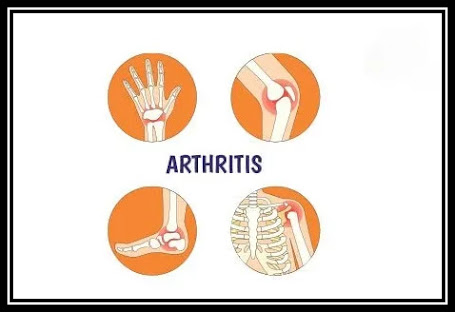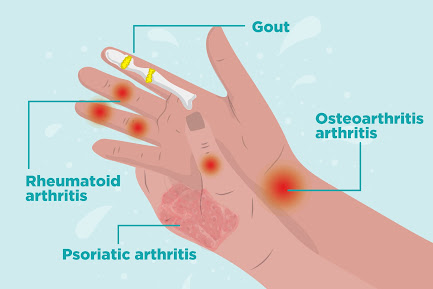Arthritis is a condition that affects millions of people worldwide, causing pain, stiffness, and swelling in the joints. It is not a single disease but a term used to describe joint pain or joint disease. There are over 100 different types of arthritis and related conditions, each with its own unique symptoms and treatment methods.
What are the Types of Arthritis:
Osteoarthritis (OA): This is the most common type of arthritis, often referred to as “wear and tear” arthritis. It occurs when the protective cartilage that cushions the ends of your bones wears down over time.
Rheumatoid Arthritis (RA): An autoimmune disorder where the immune system attacks the joints, causing inflammation, pain, and eventually joint damage.
Psoriatic Arthritis: A form of arthritis that affects some people who have psoriasis, a skin condition that causes red, scaly patches.
Gout: A type of arthritis caused by the buildup of uric acid crystals in the joints, leading to sudden attacks of pain, swelling, and redness, often in the big toe.
What Are the of Symptoms of Arthritis?
Joint pain
Stiffness, especially in the morning or after periods of inactivity
Swelling around the joints
Redness and warmth around the affected area
Reduced range of motion
Fatigue
What are the Treatment Options of Arthritis?
Treatment options for arthritis aim to manage symptoms, improve joint function, and slow down the progression of the disease. Depending on the type of arthritis, treatments may include:
Medications: Pain relievers, anti-inflammatory drugs, and in some cases, disease-modifying antirheumatic drugs (DMARDs) may be prescribed.
Physical Therapy: Exercises can help improve joint function and range of motion.
Lifestyle Changes: Maintaining a healthy weight, regular exercise, and joint protection techniques can reduce pain and improve mobility.
Surgery: In severe cases, joint replacement surgery may be necessary to relieve pain and restore function.
Which Arthritis is Dangerous?
Rheumatoid Arthritis (RA)
Autoimmune Nature: RA is an autoimmune disorder where the immune system attacks the body’s own tissues, particularly the synovium (lining of the joints). This ongoing immune response can lead to chronic inflammation, joint damage, and even affect other organs in the body.
Progressive Joint Damage: Over time, untreated RA can cause irreversible joint damage, deformities, and disability. The inflammation can erode cartilage and bone within the joint, leading to pain, stiffness, and loss of function.
Systemic Effects: RA can also affect other organs and systems in the body, such as the heart, lungs, and eyes. It may increase the risk of cardiovascular disease and complications like lung inflammation (pulmonary fibrosis) or inflammation of blood vessels (vasculitis).
Early Diagnosis Challenges: Unlike osteoarthritis, which is primarily due to wear and tear on joints, RA requires early diagnosis and aggressive treatment to prevent irreversible joint damage and systemic complications.
Treatment Complexity: Managing RA often requires a combination of medications to reduce inflammation and modify the course of the disease, as well as lifestyle changes and sometimes surgical interventions to preserve joint function.
How can I control my arthritis?
Managing arthritis effectively involves a combination of lifestyle changes, medications, and other treatments. Here are some strategies to help control arthritis:
Lifestyle Changes
Maintain a Healthy Weight: Extra weight puts more pressure on weight-bearing joints, like the knees and hips.
Exercise Regularly: Low-impact activities such as walking, swimming, and cycling can help improve joint mobility and strength.
Healthy Diet: Eating a balanced diet rich in fruits, vegetables, and omega-3 fatty acids can help reduce inflammation.
Stay Hydrated: Drinking plenty of water helps maintain joint lubrication.
Avoid Tobacco and Limit Alcohol: Smoking and excessive alcohol consumption can exacerbate arthritis symptoms.
What age does arthritis start?
Arthritis can start at almost any age, but it is more common as people get older. The onset and type of arthritis vary:
Osteoarthritis (OA): Typically begins after the age of 50, though it can start earlier, especially if there’s a history of joint injury or overuse.
Rheumatoid Arthritis (RA): Can start at any age but most commonly begins between the ages of 30 and 60. Juvenile rheumatoid arthritis can affect children.
Psoriatic Arthritis: Usually develops between the ages of 30 and 50 but can start earlier or later.
Gout: More common in men, typically begins after age 30, but can occur earlier, especially in individuals with a family history or risk factors like obesity and certain dietary habits.
Juvenile Arthritis: Refers to arthritis in children under the age of 16.
Arthritis encompasses a range of joint disorders characterized by inflammation, pain, and reduced mobility, affecting people of all ages. Dr. Karan Patel, an esteemed orthopedic surgeon in Kachiguda, Hyderabad, specializes in the diagnosis and treatment of arthritis. With a patient-centered approach, Dr. Karan Patel offers cutting-edge treatments tailored to each individual, including medication, physical therapy, and surgical interventions when necessary. His expertise and compassionate care aim to relieve pain, restore joint function, and improve the overall quality of life for arthritis patients in Hyderabad and beyond.


